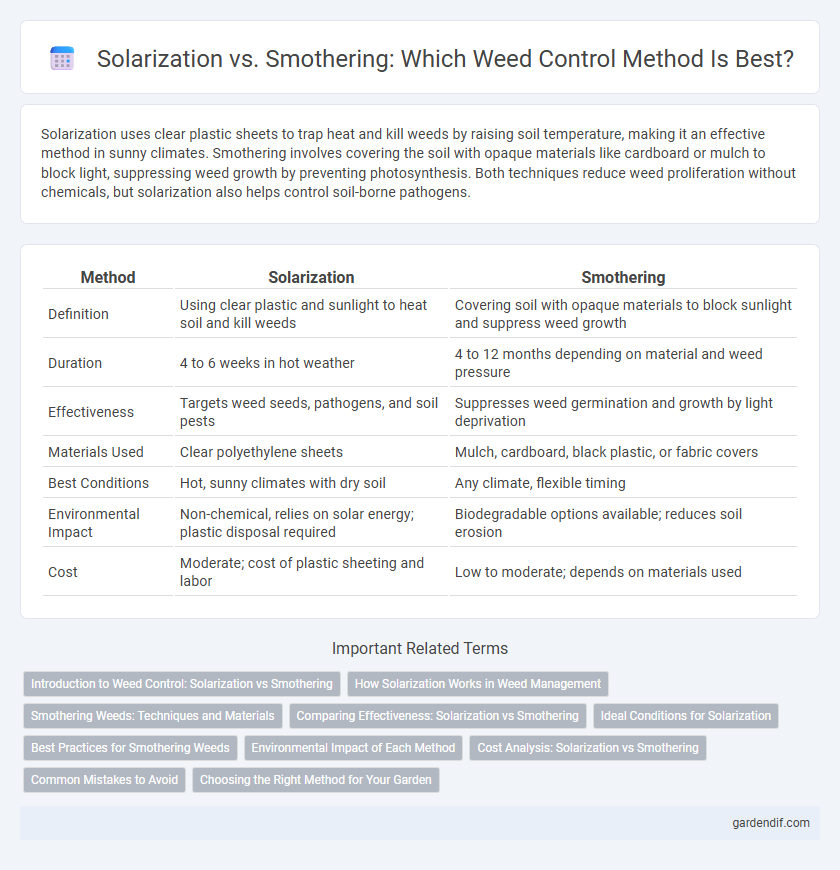
Solarization vs smothering Illustration
Solarization uses clear plastic sheets to trap heat and kill weeds by raising soil temperature, making it an effective method in sunny climates. Smothering involves covering the soil with opaque materials like cardboard or mulch to block light, suppressing weed growth by preventing photosynthesis. Both techniques reduce weed proliferation without chemicals, but solarization also helps control soil-borne pathogens.
Table of Comparison
| Method | Solarization | Smothering |
|---|---|---|
| Definition | Using clear plastic and sunlight to heat soil and kill weeds | Covering soil with opaque materials to block sunlight and suppress weed growth |
| Duration | 4 to 6 weeks in hot weather | 4 to 12 months depending on material and weed pressure |
| Effectiveness | Targets weed seeds, pathogens, and soil pests | Suppresses weed germination and growth by light deprivation |
| Materials Used | Clear polyethylene sheets | Mulch, cardboard, black plastic, or fabric covers |
| Best Conditions | Hot, sunny climates with dry soil | Any climate, flexible timing |
| Environmental Impact | Non-chemical, relies on solar energy; plastic disposal required | Biodegradable options available; reduces soil erosion |
| Cost | Moderate; cost of plastic sheeting and labor | Low to moderate; depends on materials used |
Introduction to Weed Control: Solarization vs Smothering
Weed control methods such as solarization and smothering target weed suppression through different mechanisms: solarization uses solar heat to kill weed seeds and pathogens in the soil, while smothering blocks sunlight, preventing weed germination. Solarization typically requires clear plastic sheets and several weeks of intense sunlight, making it most effective in warm climates. Smothering, using mulch or tarps, offers a more flexible, cost-effective approach applicable across seasons but may require longer periods for significant weed reduction.
How Solarization Works in Weed Management
Solarization controls weeds by using clear plastic sheets to trap solar energy, raising soil temperatures to levels that kill weed seeds, pathogens, and pests. This method is highly effective against shallow weed seeds and can improve soil health by promoting beneficial microbial activity. Soil temperatures reaching 45-60degC maintained for 4-6 weeks during peak sunlight phases ensure maximum weed seed mortality.
Smothering Weeds: Techniques and Materials
Smothering weeds involves blocking sunlight to inhibit weed growth using materials such as mulch, cardboard, or landscape fabric, which create a physical barrier that prevents photosynthesis. Organic mulches like wood chips and straw enrich soil while suppressing weeds, whereas synthetic fabrics offer longer-lasting coverage with minimal maintenance. Effective smothering requires adequate thickness and overlap to ensure complete coverage, preventing weeds from emerging through gaps.
Comparing Effectiveness: Solarization vs Smothering
Solarization uses solar heat trapped under plastic to effectively kill seeds and soilborne weed pathogens, achieving up to 90% weed seed mortality in 4 to 8 weeks under optimal sunlight. Smothering deprives weeds of light and oxygen by covering soil with mulch or fabric, effectively suppressing weed growth but often requiring longer durations and multiple layers for thorough control. Solarization provides faster and more comprehensive weed seed eradication, while smothering is more suitable for ongoing suppression and organic garden settings.
Ideal Conditions for Solarization
Ideal conditions for solarization include temperatures consistently above 110degF (43degC) during peak daylight hours and at least six weeks of direct sunlight exposure, which allows solar energy to penetrate and heat the soil effectively. Moist, loose soil enhances heat transfer, making weed seeds and pathogens more susceptible to thermal destruction. Transparent polyethylene plastic is typically used to trap solar heat, creating a greenhouse effect essential for maximizing soil solarization efficiency.
Best Practices for Smothering Weeds
Smothering weeds involves covering the soil with materials like mulch, cardboard, or landscape fabric to block sunlight and inhibit weed growth. Best practices include selecting thick, organic mulch layers of 3-4 inches for effective light blockage and moisture retention, regularly monitoring for weeds that penetrate cover and promptly removing them. Combining smothering with pre-treatment solarization can enhance weed control by weakening seed viability before applying a physical barrier.
Environmental Impact of Each Method
Solarization uses solar energy to heat the soil, effectively eradicating weeds without chemical inputs, reducing environmental pollution and preserving beneficial soil microorganisms. Smothering, through materials like mulch or plastic, blocks sunlight and depletes oxygen to suppress weed growth, but may generate plastic waste and alter soil moisture levels. Both methods have minimal carbon footprints compared to chemical herbicides, with solarization offering a sustainable, non-invasive approach that promotes long-term soil health.
Cost Analysis: Solarization vs Smothering
Solarization generally involves higher initial costs due to the purchase of clear plastic sheets and labor for installation, but it offers long-term savings by effectively sterilizing soil and reducing weed seed banks. Smothering requires less upfront investment, using organic mulches like cardboard or mulch, but may demand repeated applications and ongoing maintenance, increasing overall expenses. Cost efficiency depends on the scale of weed control, with solarization favored for intensive, long-term projects and smothering preferred for smaller, short-term weed suppression.
Common Mistakes to Avoid
Solarization often fails when soil moisture is insufficient, reducing heat absorption and allowing weed seeds to survive; ensure the soil is thoroughly watered before covering with clear plastic. Smothering mistakes include using opaque materials that do not block sunlight completely or leaving covers on too briefly, which allows weeds to regrow quickly. Avoid overlapping gaps in the cover that let light through, as even small light leaks can enable stubborn weed species to persist.
Choosing the Right Method for Your Garden
Solarization effectively controls weeds by using clear plastic to trap solar energy, raising soil temperature to levels that kill weed seeds and pathogens, making it ideal for sunny climates and areas with persistent weed problems. Smothering involves covering the soil with opaque materials like mulch or cardboard, blocking sunlight to suppress weed growth, which is suitable for gradual, low-maintenance weed management in shaded or cooler environments. Selecting the right method depends on your garden's sunlight exposure, climate conditions, and the urgency of weed control needed to improve soil health and plant growth.
Solarization vs smothering Infographic

 gardendif.com
gardendif.com